Moving Pictures
In the early 1870s, a debate raged about an apparently straightforward question—whether all four of a horse’s hooves are ever off the ground at once during a gallop. In 1872 Leland Stanford, a racehorse enthusiast and former governor of California, engaged photographer Eadweard Muybridge (1830-1904) to settle the matter.
Photographing a galloping horse presented formidable technical challenges. To achieve clarity for such rapid motion would require a very short exposure time, resulting in a dark image. Muybridge made progress by shooting on a bright day using a large aperture and a white background, which created a well-defined silhouette-like image. His success was assured with the development in 1877 of a new, and much faster, collodion called “lightning collodion.” This technique, combined with the use of multiple cameras activated by trip wire, resulted in an unprecedented exposure time estimated at a 1/500 of a second—sufficiently fast to capture clearly an image of the horse with all four hooves simultaneously off the ground.
Muybridge expanded the experiment in a direction that led to perhaps the earliest example of videography. He invented a device, the zoopraxiscope, to display his images as a moving picture. Later, at the University of Pennsylvania, he continued his photographic studies of movement with both people and animals capturing upwards of one hundred thousand images. Muybridge is thus one of the fathers of cinematography.
 |
Eadweard J. Muybridge. “Automatic Electro-photograph,” 1878. [zoom] Albumen print, 3 3/8 x 7 5/8 in. Muybridge created this motion study of a horse trotting less than one year after the development of his revolutionary “Automatic Electro-photograph.” Muybridge’s work was initially funded with $2000 from Leland Stanford who, over the next several years, invested an additional $50,000, over one million dollars in today’s money. |
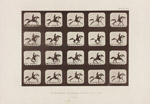 |
Eadweard J. Muybridge. “Mohammed Running.” Stillman, J. D. B. Horse in Motion. Trubner & Co, London, 1882. [zoom]
Stanford asked his friend horseman J. D. B. Stillman to publish a study of the horse in motion. Stillman used Muybridge’s photographs without crediting the photographer. The illustrations were printed with the heliotype process, a photomechanical method of printing that became popular in the 1870s. |
 |
Conventional Method of Drawing a Horse Before Muybridge's Motion Study. Harper's Weekly. October 13, 1866. [zoom]
The Horse in Motion series produced an immediate and universal change in the artistic depiction of the galloping horse. Before 1878, horses were positioned awkwardly with both front legs reaching forward and rear legs extending backward. |
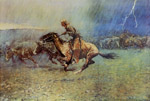 |
Frederic Remington (1861-1909). Artist Rendition of a Horse After Muybridge's Motion Study, 1908. “The Stampede” [zoom] |
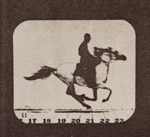 |
Eadweard J. Muybridge. Enlarged Frame From “Mohammed Running.” [zoom]
Remington likely used this image as a model for the horse in his painting, “The Stampede” (see above). |
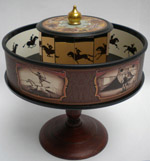 |
Praxinoscope. [zoom]
Developed in 1877 in France, the praxinoscope was a popular early animation device. Just two years later, Muybridge invented his zoopraxiscope, the first motion projector. |
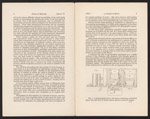 |
Illustration of the Muybridge Electro-exposer and Camera System. Muybridge, Eadweard. The Attitudes of Animals in Motion, illustrated with the Zoopraxiscope. [zoom] Additional images:  
Offprint of lecture to the Royal Institution of Great Britain, Monday March 13 1882. At a time when photographers were shooting with manually released exposures of fifteen seconds to one minute, Muybridge was able to achieve 1/500 of a second. The photographer created, in a long shed, an elaborate installation involving multiple cameras with shutters connected to electrical circuits activated by wires tripped when the horse galloped by in front of a white backdrop. Muybridge thus obtained a series of photographs showing the horse in motion. |